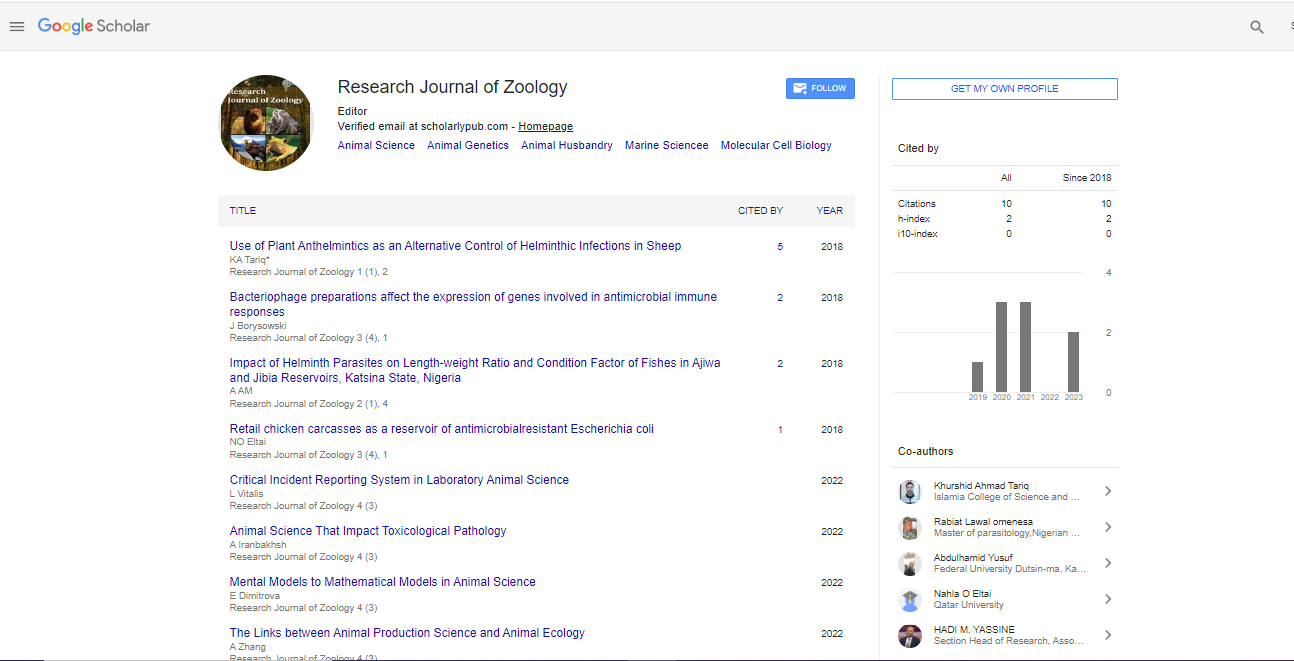Commentary, Res J Zool Vol: 5 Issue: 2
Ecdysis: The Process of Molting in Arthropods and Other Creatures
Aurelie Lazzari*
1Department of Zoology, University of Sydney, Sydney, Australia
*Corresponding Author: Aurelie Lazzari,
Department of Zoology, University of
Sydney, Sydney, Australia
E-mail: lazzariaurelie@gmail.com
Received date: 15 May, 2023, Manuscript No RJZ-23-107051;
Editor assigned date: 17 May, 2023, PreQC No RJZ-23-107051 (PQ);
Reviewed date: 01 June, 2023, QC No RJZ-23-107051;
Revised date: 08 June, 2023, Manuscript No RJZ-23-107051 (R);
Published date: 16 June, 2023, DOI: 10.4172/Rjz.1000087
Citation: Lazzari A (2023) Ecdysis: The Process of Molting in Arthropods and Other Creatures. Res J Zool 5:2.
Description
Ecdysis, commonly known as molting, is a fascinating biological process observed in various animals, particularly in arthropods. This phenomenon involves the shedding of an outer layer, such as the exoskeleton, skin, or cuticle, to accommodate growth and development. Ecdysis is a imporatant and well-coordinated event in the life cycle of many invertebrates, allowing them to adapt to changing environmental conditions and continue their growth.
The process of ecdysis
The process of ecdysis involves several stages
Preparation: Before molting, an animal undergoes a pre-ecdysis phase. During this time, the inner layers of the exoskeleton or cuticle begin to detach from the body's epidermal cells. A new, larger exoskeleton or cuticle also starts to form beneath the old one.
Softening of the old exoskeleton: Enzymes and other substances are secreted between the old exoskeleton and the epidermis, softening the old cuticle and creating a space for the animal to shed it.
Shedding: The animal then separates itself from the old exoskeleton, often by inflating its body with fluid or air. The exoskeleton splits along predetermined lines, and the animal gradually emerges from the old cuticle.
Hardening of the new exoskeleton: Once free from the old exoskeleton, the new, soft cuticle begins to harden and calcify. This process can take several hours to complete.
Recovery: After molting, the animal is vulnerable due to the softness of its new exoskeleton. It will hide and avoid predators until its new cuticle hardens sufficiently to provide protection.
Significance and adaptations
Ecdysis offers numerous advantages and adaptations for animals
Growth: Ecdysis enables animals to grow larger as they outgrow their current exoskeleton or cuticle. Shedding the old, rigid outer layer allows for expansion and the formation of a larger and more accommodating covering.
Repair and regeneration: Molting is also a mechanism for repairing damaged or injured exoskeletons. If an animal has sustained injuries, molting provides an opportunity for regeneration and replacement of damaged body parts.
Adaptation to environmental changes: Ecdysis allows animals to adapt to changes in their environment, such as variations in temperature, humidity, or nutrient availability. Shedding the old exoskeleton can help them deal with adverse conditions or escape from tight spaces.
Metamorphosis: In some animals, ecdysis is an integral part of their life cycle and is associated with distinct developmental stages, such as metamorphosis in insects. The process of molting facilitates the transition from one life stage to another, enabling significant changes in body form and function.
Examples of ecdysis in different organisms
Arthropods: Ecdysis is most commonly associated with arthropods, including insects, spiders, crustaceans, and centipedes. In insects, molting is a important aspect of their life cycle, as they typically undergo several molts during their development from egg to adult.
Reptiles: Some reptiles, such as snakes and lizards, also undergo ecdysis. They shed their outer layer of scales or skin periodically, allowing for growth and removing old and damaged scales.
Amphibians: Many amphibians, such as frogs and salamanders, undergo ecdysis during their transformation from aquatic larvae (e.g., tadpoles) to terrestrial adults.
Conclusion
Ecdysis, the remarkable process of molting, plays a vital role in the growth, development, and adaptation of various animals, particularly in the arthropod group. The shedding of an outer covering allows for growth, regeneration, and metamorphosis, ensuring these creatures can thrive and survive in their ever-changing environments. Understanding ecdysis provides a deeper appreciation for the intricate ways in which organisms evolve and adapt to the challenges of life on Earth.
 Spanish
Spanish  Chinese
Chinese  Russian
Russian  German
German  French
French  Japanese
Japanese  Portuguese
Portuguese  Hindi
Hindi 
